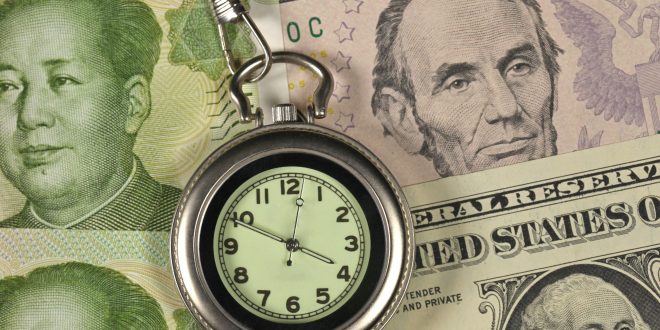The forex markets ended the week’s trading negatively, especially after Russia bombed one of the largest nuclear power plants in Ukraine.
The US dollar ended the trading on significant gains, taking advantage of the war in Ukraine, in addition to the speech of Jerome Powell, Chairman of the Board of Governors of the Federal Reserve, which calmed expectations of a rate hike.
The US currency also benefited from a significant improvement in US employment data.
Nonfarm Payrolls (NFP) rose by 678K in February, well above the median economist forecast for a 400K rise, data published by the US Bureau of Labor Statistics showed on Friday. January’s NFP number also saw a small upwards revision to 481K from 467K. The much larger-than-expected headline beat was driven by a 654K rise in Private Nonfarm Payrolls versus the expected 378K gain. January’s number also revised slightly higher to 448K from 444K.
The dollar index, which measures the performance of the US currency against a basket of major currencies, rose to 98.51 points, compared to last week’s closing at 97.18 points.
The index recorded the lowest levels over the past week at 97.84 points, compared to the highest levels, which recorded 98.92 points.
The euro fell to its lowest level in nearly six years against the pound and remained near its lowest level in 21 months against the dollar on Thursday after a new rise in energy prices intensified fears about the direction of the economic outlook in the eurozone.
The single currency fell 0.3 percent to $1.1086, to settle near the $1.1058 level it fell to on Wednesday, its lowest since May 2020.
The euro fell this week by 1.6 percent, as it is heading to record the fourth consecutive weekly decline against the US currency.
The Australian dollar rose to its highest level since mid-November at $0.7323 as prices for Australian exports such as coal, gas and grain rose amid signs that sanctions against Russia are severely disrupting global supplies.
But it fell towards the end of the trading session to $0.7298, slightly higher than the previous day.
The dollar index rose 0.2 percent and the dollar rose against the Japanese currency 0.2 percent to 115.74 yen, while the sterling pound fell 0.3 percent to 1.3364 dollars.
On Friday, the price of palladium jumped above $ 3,000 an ounce, for the first time since May 2021, as fears of a shortage of supplies from Russia, the main exporter of the metal, grew, while the war in Ukraine boosted demand for gold as a safe haven.
And palladium increased in spot transactions 8.4 percent to $ 3,008.74 an ounce during the session, and it was traded at 1930 GMT, up 7.6 percent at $2985.54 an ounce.
Russia produces 40 percent of global production of the metal used in the auto industry, which is on track to achieve a 25 percent increase this week, its best level since the end of March 2020.
Wall Street
Wall Street closed lower on Friday, as war fears in Ukraine outweighed data showing job growth accelerating in the United States last month, pointing to the economy’s strength.
A report from the US Department of Labor showed greater-than-expected job growth of 678,000 jobs last month, and the unemployment rate fell to 3.6 percent, the lowest level since February 2020.
The Standard & Poor’s 500 index fell 0.79 percent to close at 4,328.87 points.
The Nasdaq Composite Index lost 1.66% to close at 13,313.44 points.
The Dow Jones Industrial Average also fell 0.53 percent to 33,614.8 points.
Oil
Crude oil prices jumped 7 percent on Friday in a volatile session, as fears of disruption to Russian oil exports due to Western sanctions outweighed expectations of an increase in Iranian crude supplies if Washington concludes a nuclear deal with Tehran.
Prices soared early in the session after Russian forces in Ukraine seized Europe’s largest nuclear power plant in what Washington called a “reckless” attack threatened catastrophe. However, a fire in a training building was put out and officials said the site was safe.
Gains increased after the administration of US President Joe Biden said it was looking at options to stop US imports of Russian oil and was studying possible measures to reduce the impact on global supplies and consumers.
Crude prices have jumped more than 20 percent since the United States and its allies imposed sanctions on Russia following its February 24 invasion of Ukraine. As a result, Russian oil sales have been turbulent, with sellers struggling to close deals despite offering deep discounts on benchmark Brent crude prices.
The price of Brent crude jumped $7.65, or 6.9 percent when it settled to $118.11 a barrel.
US West Texas Intermediate crude rose $8.01, or 7.4 percent, to $115.68 a barrel.
That was the highest closing level for Brent since February 2013, and the highest for US crude since September 2008.
Europe
European shares tumbled on Friday to their lowest levels in nearly a year, with automakers and banks plunging on reports of a nuclear power plant fire amid heavy fighting between Ukrainian and Russian forces.
The pan-European Stoxx 600 index fell 3.6 percent at the close. This week, the index lost 7 percent, its worst performance since a wave of losses due to the pandemic in March 2020.
The index has fallen more than 6 percent since the start of the Russian invasion of Ukraine last week, as Europe is the region most affected by the conflict due to its dependence on Russia for energy and its geographical proximity to the conflict.
 Noor Trends News, Technical Analysis, Educational Tools and Recommendations
Noor Trends News, Technical Analysis, Educational Tools and Recommendations





